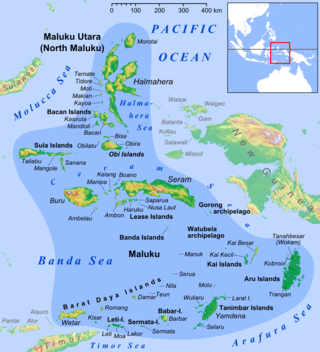
The Maluku Islands or the Moluccas are an archipelago in the eastern part of Indonesia. Tectonically they are located on the Halmahera Plate within the Molucca Sea Collision Zone. Geographically they are located east of Sulawesi, west of New Guinea, and north and east of Timor. Lying within Wallacea, the Moluccas have been considered a geographical and cultural intersection of Asia and Oceania.

Malay is an Austronesian language that is an official language of Brunei, Indonesia, Malaysia, and Singapore, and that is also spoken in East Timor and parts of Thailand. Altogether, it is spoken by 290 million people across Maritime Southeast Asia.

North Maluku is a province of Indonesia. It covers the northern part of the Maluku Islands, bordering the Pacific Ocean to the north, the Halmahera Sea to the east, the Molucca Sea to the west, and the Seram Sea to the south. It shares maritime borders with North Sulawesi, Southeast Sulawesi and Central Sulawesi to the west, Maluku to the south, Southwest Papua to the west, and Palau and the Philippines to the north. The provincial capital is Sofifi on the largest island of Halmahera, while the largest city is the island city of Ternate. The population of North Maluku was 1,038,087 in the 2010 census, making it one of the least-populous provinces in Indonesia, but by the 2020 Census the population had risen to 1,282,937, and the official estimate as at mid 2022 was 1,319,338.
In addition to its classical and literary form, Malay had various regional dialects established after the rise of the Srivijaya empire in Sumatra, Indonesia. Also, Malay spread through interethnic contact and trade across the south East Asia Archipelago as far as the Philippines. That contact resulted in a lingua franca that was called Bazaar Malay or low Malay and in Malay Melayu Pasar. It is generally believed that Bazaar Malay was a pidgin, influenced by contact among Malay, Hokkien, Portuguese, and Dutch traders.
Manado Malay, or simply the Manado language, is a creole language spoken in Manado, the capital of North Sulawesi province in Indonesia, and the surrounding area. The local name of the language is bahasa Manado, and the name Minahasa Malay is also used, after the main ethnic group speaking the language. Since Manado Malay is used primarily for spoken communication, there is no standard orthography.

The West Papuan languages are a proposed language family of about two dozen non-Austronesian languages of the Bird's Head Peninsula of far western New Guinea, the island of Halmahera and its vicinity, spoken by about 220,000 people in all. It is not established if they constitute a proper linguistic family or an areal network of genetically unrelated families.

The South Halmahera–West New Guinea (SHWNG) languages are a branch of the Malayo-Polynesian languages, found in the islands and along the shores of the Halmahera Sea in the Indonesian province of North Maluku and of Cenderawasih Bay in the provinces of Papua and West Papua. There are 38 languages.
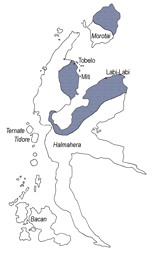
Tobelo is a North Halmahera language spoken on the eastern Indonesian island of Halmahera and on parts of several neighboring islands. The Tobelo-speaking heartland is in the six administrative districts of Tobelo, located on the western shore of Kao Bay and forming the central part of Halmahera Utara Regency. Other Tobelo-speaking areas are the five districts of Wasile on the southern and eastern shores of Kao Bay, and the northern half of Morotai Island. The district capital, also known as Tobelo, serves as a regional commercial and administrative center and is the largest settlement on Halmahera.
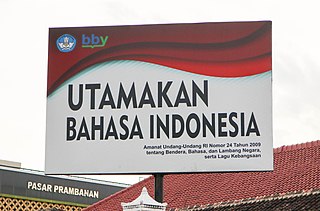
More than 700 living languages are spoken in Indonesia. This figure indicates that Indonesia has about 10% of the world's languages, establishing its reputation as the second most linguistically diverse nation in the world after Papua New Guinea. Most languages belong to the Austronesian language family, while there are over 270 Papuan languages spoken in eastern Indonesia. The language most widely spoken as a native language is Javanese.
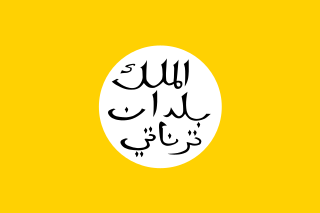
The Sultanate of Ternate, previously also known as the Kingdom of Gapi is one of the oldest Muslim kingdoms in Indonesia besides the sultanates of Tidore, Jailolo, and Bacan.
The Minahasan languages are a subgroup of the Austronesian languages spoken by the Minahasa people in northern Sulawesi, Indonesia. They belong to the Philippine subgroup.
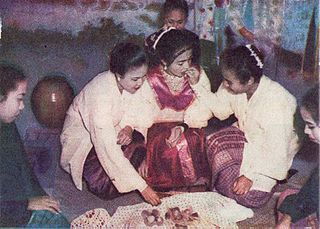
Moluccans are the Austronesian-speaking and Papuan-speaking ethnic groups indigenous to the Maluku Islands, Eastern Indonesia. The region was historically known as the Spice Islands, and today consists of two Indonesian provinces of Maluku and North Maluku. As such, "Moluccans" is used as a blanket term for the various ethnic and linguistic groups native to the islands.
Ternate is a language of northern Maluku, eastern Indonesia. It is spoken by the Ternate people, who inhabit the island of Ternate, as well as many other areas of the archipelago. It is the dominant indigenous language of North Maluku, historically important as a regional lingua franca. A North Halmahera language, it is unlike most languages of Indonesia which belong to the Austronesian language family.
West Bird's Head languages are a small family of poorly documented Papuan languages spoken on the Bird's Head Peninsula of New Guinea.
West Makian is a divergent North Halmahera language of Indonesia. It is spoken on the coast near Makian Island, and on the western half of that island.

The North Halmahera (NH) languages are a family of languages spoken in the northern and eastern parts of the island of Halmahera and some neighboring islands in Indonesia. The southwestern part of the island is occupied by the unrelated South Halmahera languages, which are a subgroup of Austronesian. They may be most closely related to the languages of the Bird's Head region of West Papua, but this is not well-established.
Tambora is the poorly attested non-Austronesian (Papuan) language of the Tambora culture of central Sumbawa, in what is now Indonesia, that was made extinct by the 1815 eruption of Mount Tambora. It was the westernmost known Papuan language and was relatively unusual among such languages in being the language of a maritime trading state, though contemporary Papuan trading states were also found off Halmahera in Ternate and Tidore.
Tondano is an Austronesian language spoken in the Tondano area of northeast Sulawesi, Indonesia. It is most similar to Tombulu and to Tonsea.
Bacan Malay or Bacan is a Malayic language spoken on the island of Bacan in North Maluku province, Indonesia, by the minor Bacan ethnic group. It is an anomalous presence in the region, being surrounded by genetically distant Austronesian languages and languages of the unrelated North Halmahera family. Bacan is geographically removed from the Malay heartlands in the western archipelago.
The Tidore are a major ethnic group living in North Maluku province of Indonesia. They primarily live in Tidore island and also in some parts of Halmahera. They speak the Tidore language. The Tidore people are predominantly Muslims and famous as the founders of the Tidore Sultanate, the easternmost Islamic kingdom in the world along with Ternate, Jailolo and Bacan.










